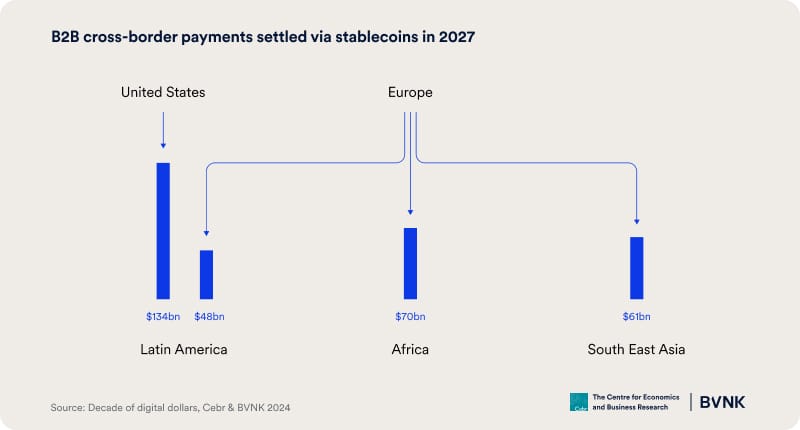$11.6bn of business capital trapped in slow payment systems at any given second, could be released by stablecoins, says new report by Cebr and BVNK on 10th anniversary of stablecoins

- July marks 10 years since the launch of the first stablecoin; market cap now $160bn
- New analysis from the Centre of Economics & Business Research (Cebr) shows high demand for stablecoins: businesses & consumers in 17 countries willing to pay 4.7% average premium for access to stablecoins, up to 30% in Argentina.
- Analysis reveals potential impact of stablecoins in mitigating losses from currency volatility in emerging markets: losses total 9.4% of GDP avg in countries studied.
- Report highlights impact of instant-settling stablecoins on cross-border payments. In 2024, there will be $2.8 trillion cross-border stablecoin payments, releasing idle working capital 3-6 days sooner across 4 major routes. At any given moment, $11.6bn of business capital is trapped in traditional B2B payment systems between these 4 routes, constraining business growth.
BVNK, the B2B payments provider and Cebr, the Centre for Economics and Business Research, have published new analysis on the economic impact of stablecoins, on the 10th anniversary of the first stablecoin launching. As the stablecoin market cap reaches $160bn, the new report demonstrates for the first time the quantitative link between increasing stablecoin use and economic impact.
Economic impact of stablecoins revealed
New analysis from Cebr highlights key impacts of fiat-backed stablecoins on the economy:
1. Mitigating costs of currency volatility:
Stablecoins, predominantly pegged to the US dollar (>99% by market capitalisation), can help offset GDP losses from local currency volatility in emerging economies. These losses totalled 9.4% of GDP on average since 1992 across 17 countries studied, with significant impact in Indonesia ($184bn) and Brazil ($172bn). Stablecoins can protect consumer savings and business balance sheets from the impact of inflation, and enable businesses to avoid unfavourable commercial contracts due to currency devaluation.
2. Bridging the dollar gap:
As a digital substitute for the US dollar, stablecoins fulfil international demand for a stable, global currency, where access is limited. Cebr analysis in 17 countries showed significant demand for stablecoins in emerging economies, with businesses and consumers willing to pay an average premium of 4.7% over the standard dollar price to access stablecoins – rising to 30% in countries like Argentina. By 2027, it is estimated that these 17 countries will pay $25.4 billion in premium alone to access stablecoins.
3. Releasing trapped capital:
Today’s cross-border payment systems are associated with long delays in transferring funds, trapping working capital and requiring financial services providers to hold money in pre-funded accounts to mitigate risk. Cebr examined 4 major B2B routes with settlement delays where at any given moment, $11.6 billion of working capital is trapped. This capital is unavailable for growth, representing a significant opportunity cost for businesses.
Stablecoins are speeding up global settlement: in 2024, there will be $2.8 trillion cross-border stablecoin payments, releasing funds 3-6 days sooner across the routes studied. For businesses, especially SMEs, this improves liquidity, reduces the costs of borrowing and enhances operational efficiency. It also has direct financial benefit: generating a $2.9 billion return for businesses by 2027 across 4 routes (which represent c.10% of cross-border payments volume). By enabling near instant settlement, stablecoins also bypass the need to pre-fund accounts, potentially releasing more than $5 trillion in locked capital.
Ben Reynolds, MD of BVNK US, commented: “Businesses are diversifying their supply chains, and growing their customer bases globally. For many, it’s hard to get access to strong fiat currencies, and it’s hard to move money quickly across borders. These aren’t just inconveniences, they directly impact capital efficiency and liquidity. Stablecoins bring the full utility of the internet to payments, connecting buyers and sellers globally in an instant. For businesses, they offer a powerful alternative to today's slow, clunky cross-border payment systems.”
Nina Skero, Chief Executive at Cebr, commented: “Businesses and economies lose out when funds are locked up in slow payment systems and can suffer from local currency volatility. Cebr partnered with BVNK to explore how the increasing global adoption of stablecoins alleviates these problems. Among other benefits, stablecoins can streamline the payments process, releasing idle capital that can be put to a productive purpose. In selected routes representing approximately 10% of cross-border payments, we find that faster stablecoin transactions will unlock $2.9 billion in increased economic output by 2027.”
Chris Harmse, BVNK Co-founder, commented: “With industry leaders already predicting the stablecoin market cap will grow from $160bn to $1 trillion in the next few years, stablecoin payment volumes could reach $15 trillion by 2030. We believe the rise of yield-bearing stablecoins will also have a huge industry impact. At 3% interest rates, stablecoin issuers could generate $30bn a year in economic value on stablecoin deposits through yield alone by 2030.”
Access the full report from Cebr and BVNK (from 25 July), including case studies and comment from Circle, Visa, Worldpay, Chainalysis and First Digital: www.bvnk.com/report/decade-of-digital-dollars




